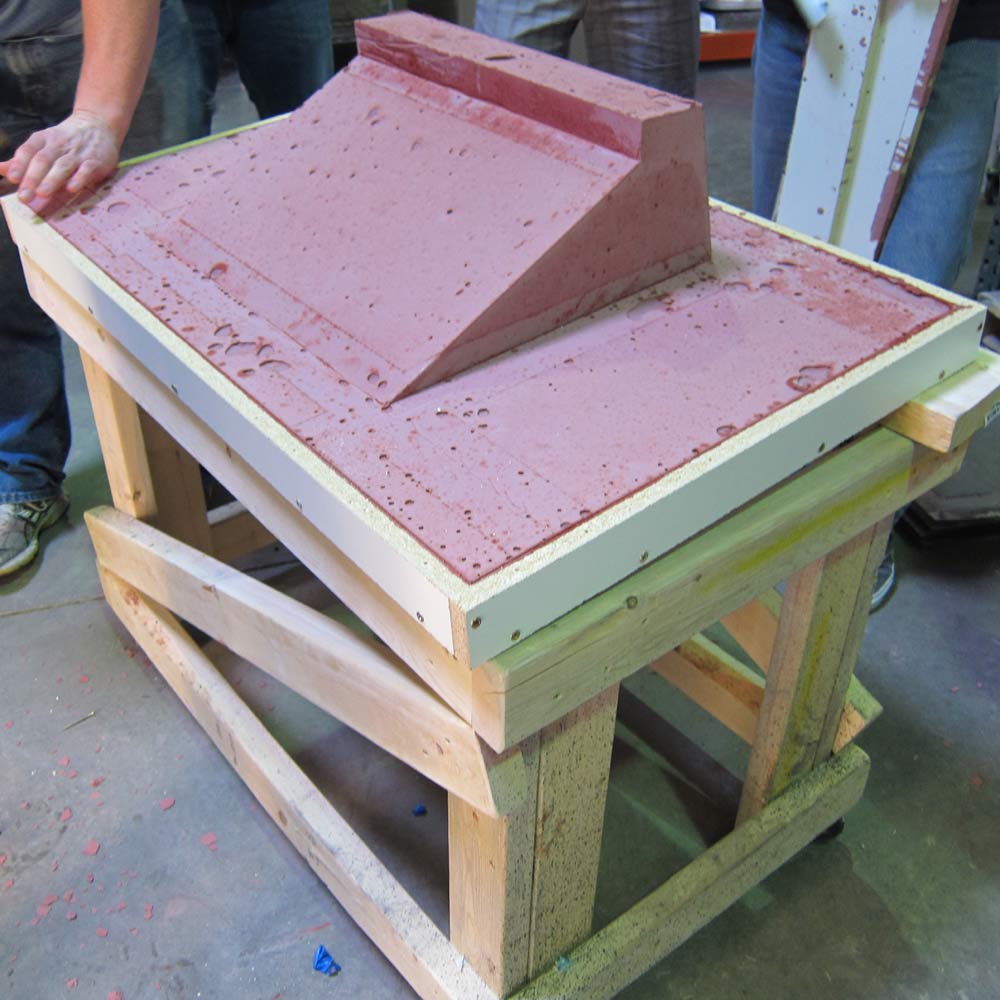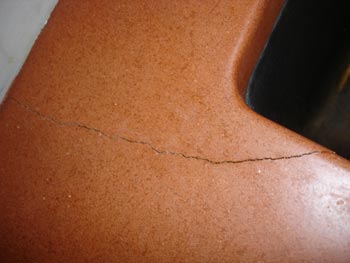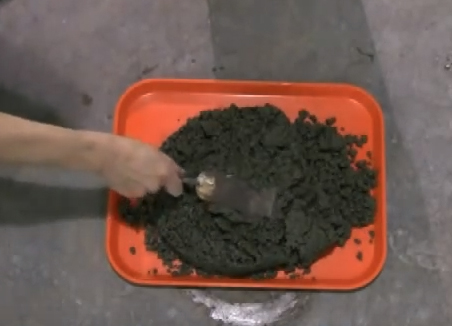Murphy’s Law states, “Anything that can go wrong will go wrong.” This doesn’t have to be the case with concrete countertops. With some basic knowledge, you can prevent these basic problems with concrete countertop mix designs. You can also use proven from-scratch mix designs such as those found in the CCI Mix Calculators.
1. Air Bubbles (Pinholes)

Underside of a wet cast ramp sink. The large holes are where air bubbles got trapped under the top cap of the mold.
All concrete will have air trapped in the mix due to the mixing process. Fine aggregates and sand tend to trap air bubbles, and a stiff cement paste won’t allow the air to rise and escape.
The only way to cast traditional concrete so there are no air bubbles (large or small) on the surface is to design the mix so that the fresh concrete is very fluid or can be made very fluid by vibration. Air cannot be made to disappear, dissolve or not get entrapped by adding an admixture. Only a very fluid concrete will allow the air bubbles to push their way through the concrete and rise to the surface.
Often the cast surface will be hole-free but any significant grinding will reveal tiny pinholes just below the surface. Large air bubbles have enough buoyant force to push aside the aggregate and escape, while the smallest bubbles get left behind because they are too small and not buoyant enough to push their way through the concrete.
Defoamers such as UltraDense work by preventing stable air bubbles from forming during mixing. Defoamers don’t make air disappear, rather they reduce the cement paste’s surface tension characteristics so bubbles are harder to form. The concrete still needs to be fluid enough to allow the bubbles to escape.
It is often nearly impossible to completely eliminate pinholes. In this case, you can fill them in with a fine cement paste called grout. (This is sometimes called slurry, incorrectly. Slurry is the dirty water produced by wet grinding concrete.)
For a detailed grouting procedure, see this article.
Pinholes in GFRC
When working with GFRC, the energy of spraying the mist coat lays down a thin veneer with no air bubbles. It is still important to use defoamer with liquid GFRC polymers because denser GFRC is stronger GFRC.
It is also possible to direct cast GFRC. This is essentially casting a fluid backer without mist coat. With this technique, it’s possible for fibers to show and for trapped air to cause pinholes to show. The shape of the piece dictates whether you can get a good casting – air rises, so horizontal surfaces may be fine, but vertical surfaces probably will have some exposed air voids. This is also true for traditional wet cast concrete.
2. Curling
“Concrete mixes that are shrinkage prone will curl more than mixes that are shrinkage resistant.”
Curling is caused by poor curing and storage conditions. When one side of a concrete slab is allowed to dry out while the other side remains moist (or is moister), the concrete will tend to shrink towards the dry side. Prolonged moist curing, and storing the slabs so both sides get even airflow, can control curling.
As a general rule, traditional concrete should moist cure for a minimum of 5-7 days before being allowed to slowly and evenly dry out. However, most concrete countertop artisans use high-performance mixes that allow for a cure time of 1-2 days before proceeding with processing and sealing.
GFRC does not need to be moist cured. GFRC uses a polymer that acts as an internal barrier to keep moisture inside, and that is what achieves “moist curing” over 5-7 days. GFRC should still be kept evenly moist/dry on both sides.
Concrete mixes that are shrinkage prone will curl more than mixes that are shrinkage resistant. Good aggregate gradation, lower cement contents, and low water-cement ratios are the key to making shrinkage resistant concrete. In addition, shrinkage reducing admixtures (SRA) can manage or reduce shrinkage and curling. Some shrinkage reducing admixtures increase the mix water demand and may reduce the strength of the concrete.
For GFRC, the base mix design is extremely shrinkage prone because it is so cement rich. Furthermore, GFRC tends to be used for large, thin slabs which exacerbates the tendency to curl. Make sure that GFRC slabs are well supported so they don’t sag, and ensure there is good airflow under the slab so that moisture doesn’t build up and create differential shrinkage.
3. Hairline Cracks
Hairline cracks (and all cracks for that matter) form when tension forces in the concrete exceed the tensile strength of the concrete. Tension forces in the concrete can be generated from shrinkage, heat or deflection.
Generally, hairline cracks are very narrow and represent a stress-relief response to the excessive tension force. Larger cracks tend to be caused by bending forces that generate large deflections that open up the cracks.
Most hairline cracks form over time as the concrete dries out and shrinkage stresses build up. Keys to managing shrinkage involve good curing, good mix design and possibly the use of SRA’s; see Curling, above.
Heat can cause micro-cracking where the concrete develops micro-hairline spider web or map cracks. Often these can only be seen if water or other liquid is applied to the affected concrete. The use of PVA or AR glass fibers, good curing, and good aggregate gradations can minimize the effects of intense heat. Limiting the temperature and/or duration of heating will greatly reduce the likelihood of thermal cracking.
Bending, due to uneven supports or excessive loading, can cause hairline cracks. If the concrete just cracks but does not open up, and if the load that caused the crack is removed, then the resulting crack is often called a hairline crack. If the load is high enough or sustained, and movement is allowed, then the crack can open up. This is what is called a structural crack.
4. Harsh or Stiff Mix
Harsh mixes usually have too much large aggregate or very rough, angular aggregate. This is an issue only with traditional aggregate-based concrete mixes.
Simply adding more cement to the concrete mix can help, but too much cement can cause excessive shrinkage. The better solution is to regrade the aggregates to allow for more fine aggregate. Often blending coarse and rounded aggregate will help with a harsh mix.
Sometimes concrete has low workability or is very stiff because it has a very low water/cement ratio. The common solution to stiff concrete is to add extra water to make it more flowable. This is a very poor solution to a common problem. Cracking, shrinkage, low strength and high porosity often result. This describes common sidewalk concrete.
The better solution is to add water reducer. Concrete countertop mixes typically use high range water reducers that are polycarboxylate based, called “superplasticizers”. Here is a video that shows how well superplasticizers work:
We now offer Integrity UltraFlow, a powerful dry powder polycarboxylate superplasticizer that provides even stronger water reducing properties than the Melflux 2651 shown in the video.
5. Segregation
“Sometimes a good concrete mix can segregate when too much superplasticizer is used.”
Ideally, all ingredients in your mix are evenly distributed. Segregation is when gravity causes the heavy ingredients such as aggregate/sand to settle, and fluid cement paste and water rise to the top.
Highly fluid concrete mixes tend to segregate if the cement paste viscosity is not stabilized. Segregation occurs when the cement paste is too fluid and not viscous enough to support and suspend the larger aggregate. What happens is that the large aggregate sinks to the bottom of the forms and the pure cement paste forms a runny, scummy layer on top of the concrete. The fluid is not water; rather it is the highly fluid cement paste that has separated from the aggregates due to gravity.
Two common solutions can solve segregation. One is to use a viscosity-modifying admixture (VMA). It’s a stabilizer and thickener.
Another solution is to increase the very fine aggregate content of the concrete. Typically fly ash, microspheres or powdered stone is added, or during the mix design, some of the coarse aggregates are replaced with equal amounts of very fine material. Typically the fine material accounts for about 5% by volume of concrete.
Sometimes a good concrete mix can segregate when too much superplasticizer is used, or, the wrong superplasticizer is used in the attempt to create a highly fluid mix. Polycarboxylate superplasticizers have paste stabilization characteristics that other superplasticizers don’t, and the use of either VMA’s or extra fines can augment the stabilization.
6. Long Set Time/Low Early Strength
Several factors influence the set time for concrete. These include temperature, admixtures, and water content.
Temperature: Colder temperatures slow the hydration rate, increasing set time and strength development. In contrast, high temperatures sometimes speed the set time so much that you can’t work with the concrete fast enough. In this case I use ice as a substitute for some of the mix water. Both are measured by weight.
Admixtures: Chemical retarders, some synthetic pigments, some liquid pigments, low reactivity pozzolans used as cement replacements, and some water reducers can all slow or retard the setting rate of concrete.
Water content: High w/c ratios also slow the setting time somewhat.



